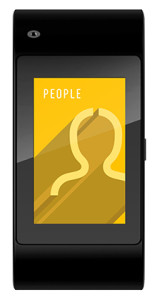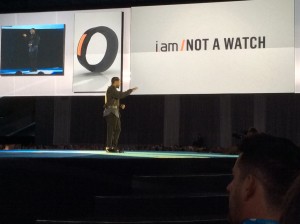 In the normal course of business, most product launches are one-day stories. Two days, tops, if they’re really big and they’re not from Apple or (sometimes) Google. In truth, that’s fine; it’s the rare product that deserves more.
In the normal course of business, most product launches are one-day stories. Two days, tops, if they’re really big and they’re not from Apple or (sometimes) Google. In truth, that’s fine; it’s the rare product that deserves more.
Will.i.am’s Puls wristware deserves more, because the thinking behind it is so uncommon.
First of all, the Puls cuff is unapologetically fashion-oriented. The only other major tech product we can think of that can make that statement is the Apple Watch. You may have an opinion about the design — and about the last people to have valid opinions about fashion design are tech journalists — but the design is assertive. There’s thought and intent behind it. Yes, it’s kind of massive, but not as much as one might think; it’s about as wide as the widest part of a Pebble watch. People do wear cuffs; it’s not a coincidence that Intel and Opening Ceremony are also building cuffs.
In truth, the Puls represents good technical design. The magnetic clasp is terrific. The screen is clear and the use of passive OLED is quite a good tradeoff between quality and power requirements. The user interface will take a little practice but at first use seemed at least OK. The decision to build a custom interface, rejecting the easy off-the-shelf choices, was breathtakingly audacious. The decision to build in a SIM and not rely on a companion smart phone was incredibly gutsy and added a level of complexity that most designers would have fled from.
It would have been the easiest thing in the world for will.i.am to have found some willing manufacturer and slap his name on something that would have been OK. He’s have sold a bunch because of the label, taken his licensing money, and gone home. Frankly, that’s what an awful lot of people at the Dreamforce conference were expecting.
But that wasn’t the plan. You listen to this guy and watch him in action, and there’s never a doubt: this is his product. This is his business. He made all the hard decisions and he put up the money. It doesn’t mean he did the coding or the hardware build or decided which chips were going in the thing. That’s what engineers and programmers are for. (About 30 of them were in San Francisco for the launch from their home bases in Singapore and India.) But it’s his blood, sweat, money and hopes on the line: William Adams from the Boyle Heights neighborhood of Los Angeles.
 The thinking goes beyond the device, too. It didn’t get much press, but there’s a line of tech clothing that goes along with the Puls. A jacket with batteries woven in that attach to the Puls’s charging contacts. Shoes that track movement. A backpack with speakers and batteries. Would we wear it? No, we’d look stupid, and we’re not in the demographic. But this stuff wasn’t made for us, and that’s the exact point. It was fashion with tech built in, not tech with fashion sprayed on as an afterthought.
The thinking goes beyond the device, too. It didn’t get much press, but there’s a line of tech clothing that goes along with the Puls. A jacket with batteries woven in that attach to the Puls’s charging contacts. Shoes that track movement. A backpack with speakers and batteries. Would we wear it? No, we’d look stupid, and we’re not in the demographic. But this stuff wasn’t made for us, and that’s the exact point. It was fashion with tech built in, not tech with fashion sprayed on as an afterthought.
That was the point Andre Leon Talley was making. There couldn’t have been more than a couple of dozen people in the crowd of thousands who knew who Talley was. This was a tech conference, after all. Talley is a long-time top editor at Vogue, sort of Anna Wintour’s other brain. If one could translate the firmament of fashion to the firmament of tech, Talley sits somewhere between Steven Jobs and Jonny Ive. His endorsement was a very big deal, and he got it exactly right when he declared that fashion has been left at the gate in these early days of wearable tech, and that’s a problem for both the fashion and tech industries. We wish our note-taking was better, but check this:
“I shouldn’t have to sacrifice form over function… Why can’t these devices be fashionable? Where is the fabulous in wearables? Most of what i see is ghastly. It looks too much like technology. Make it fabulous and allow people to connect and express themselves.”
At their best, fashion and technology are both about letting people express themselves. The Puls is one of many starts, but it’s one of the few that started from a heart of fashion. It may not ultimately succeed (although we suspect that the metric of “success” may be unusual), but the thinking behind it makes it significant and worth rooting for.